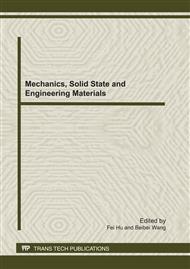[1]
K.F. Nilsson, V.Vokal: Analysis of ductile cast iron tensile tests to relate ductility variation to casting defects and material microstructure. Mater. Sci. Eng. A, Vol. 502(2009), pp.54-63.
DOI: 10.1016/j.msea.2008.09.082
Google Scholar
[2]
C.H. Hsu, S.C. Lee, Y.H. Shy, W.T. Chiou: Relationship between dynamic and static toughness of flake and compacted graphite cast irons. Mater. Sci. Eng. A, 282, 1-2(2000), pp.115-122.
DOI: 10.1016/s0921-5093(99)00765-0
Google Scholar
[3]
S.Jung, T.Ishikawa, S.Sekizuka, H.Nakae: Effects of sulfur on interfacial energy between Fe-C melt and graphite. J.Mater.Sci., 40, 9-10(2005), pp.2227-2231.
DOI: 10.1007/s10853-005-1938-3
Google Scholar
[4]
M.Tsujikawa, K.Nagamine, A.Ikenaga, M.Hino: Influence of graphite morphology on dry sliding wear of flake graphite cast irons. Int.J.Cast Met.Res. Vol. 21(2008), pp.76-80.
DOI: 10.1179/136404608x361701
Google Scholar
[5]
Wang Liping, Guo Erjun, Chen Hongbin: Effects of light and heavy rare earths on anti-degradation of nodular cast iron. Journal of rare earths Vol. 24 (2006), pp.103-107.
DOI: 10.1016/s1002-0721(06)60074-4
Google Scholar
[6]
H.W. Hoover: A Literature Survey on Degenerate Graphite in Heavy Section Ductile Iron. AFS Trans. Vol. 94(1986), pp.601-608.
Google Scholar
[7]
I.Asenjo, P.Larranaga, J.Sertucha, R.Suarez, J.M. Gomez, I.Ferrer, J.Lacaze: Effect of mould inoculation on the formation of chunky graphite in heavy-section spheroidal graphite cast iron parts. Int.J.Cast Met. Res., 20, 6(2007), pp.319-324.
DOI: 10.1179/136404608x286138
Google Scholar
[8]
C.Labrecque, M.Gagné.: Review ductile iron: fifty years of continuous development Can. Metall. Quart., 37, 5(1998), pp.343-378.
DOI: 10.1179/cmq.1998.37.5.343
Google Scholar
[9]
Z.Zhang, H.M. Flower, Y.Niu: Classification of degenerate graphite and its formation processes in heavy section ductile iron. Mater.Sci.Technol. Vol. 5(1989), pp.657-664.
DOI: 10.1179/mst.1989.5.7.657
Google Scholar
[10]
H.Itofuji, H.Uchikawa: Formation Mechanism of Chunky Graphite in Heavy-Section Ductile Cast Irons. AFS Trans. Vol. 98(1990), pp.429-448.
Google Scholar
[11]
C.R. Loper, R.W. Heine, R.W. Reesman, and B.H. Shah: Thermal Analysis of Ductile Iron. AFS Trans. Vol. 75(1967), pp.541-547.
Google Scholar
[12]
P.K. Basutkar and C.R. Loper: Correlation of Microstructures with Thermal Analysis in Heavy Section Ductile Iron Castings. AFS Trans. Vol. 79(1971), pp.169-75.
Google Scholar
[13]
P.K. Basutkar and C.R. Loper: Effects of Cerium Additions on the Thermal Analysis of Heavy Section Ductile Iron. AFS Trans. Vol. 79(1971), pp.176-185.
Google Scholar
[14]
M. Wessén, I.L. Svensson and R. Aagaard: Influence of antimony on microstructure and mechanical properties in thick-walled ductile iron castings. Int.J.Cast Met.Res. Vol. 16(2003), pp.119-124.
DOI: 10.1080/13640461.2003.11819569
Google Scholar
[15]
Z. Ignaszak: Nodular graphite degeneration in the post-inoculated ductile iron. Int.J.Cast Met.Res. Vol. 16(2003), pp.93-97.
DOI: 10.1080/13640461.2003.11819565
Google Scholar
[16]
R. Källbom, K. Hamberg, M. Wessén and L.E. Björkegren: On the solidification sequence of ductile iron castings containing chunky graphite. Mater.Sci.Eng. Vols. A413-A414(2005), pp.346-351.
DOI: 10.1016/j.msea.2005.08.210
Google Scholar
[17]
A.Javaid, C.R. Loper: Production of Heavy-Section Ductile Cast Iron. AFS Trans. Vol.103(1995), pp.135-150.
Google Scholar
[18]
M.Bazdar, H.R. Abbasi, A.H. Yaghtin, J.Rassizadehghani: Effect of sulfur on graphite aspect ratio and tensile properties in compacted graphite irons. J. Mater.Process.Technol., 209, 4(2009), pp.1701-1705.
DOI: 10.1016/j.jmatprotec.2008.04.015
Google Scholar
[19]
Pan E.N., Chen C.Y.: Effects of Bi and Sb on Graphite Structure of Heavy-Section Ductile Cast Iron. AFS transactions Vol. 104(1996), pp.845-858.
Google Scholar


